How to automate your test with Document Matching
With Document Matching you can automatically match source documents with Excel data.
About Document Matching
Document Matching lets you automatically match Excel data with supporting documents, such as invoices, bank statements, and contracts. This automation feature will find the correct text, date and/or number in a source document, and then automatically creates a reference to your sample data. Document Matching is very useful for your Test of Detail and Test of Control procedures.
Choose your DataSnipper version to learn more about Document Matching:
👉 DataSnipper version 4.1 and earlier
👉 DataSnipper version 5.0 and later
👉 Visit most FAQs on Document Matching
DataSnipper version 4.1 and earlier
Getting started with Document Matching
Learn how to get started with Document Matching, we will guide you through an example Invoice Vouching procedure. Once you understand the concept, you can apply the automation of Document Matching on different vouching and reconciliation procedures.
Video Tutorial
Advanced options in Document Matching
Learn about the more advanced options in Document Matching. To make sure you always get the best results.
Step-by-step
Prerequisites
- Received documents from the client
- Sample data ready in Microsoft Excel
- Determine the data fields you like to test
Start Document Matching
- Click import documents to import the financial documents related to the sample
- Select the documents you want to import
- Click Document Matching
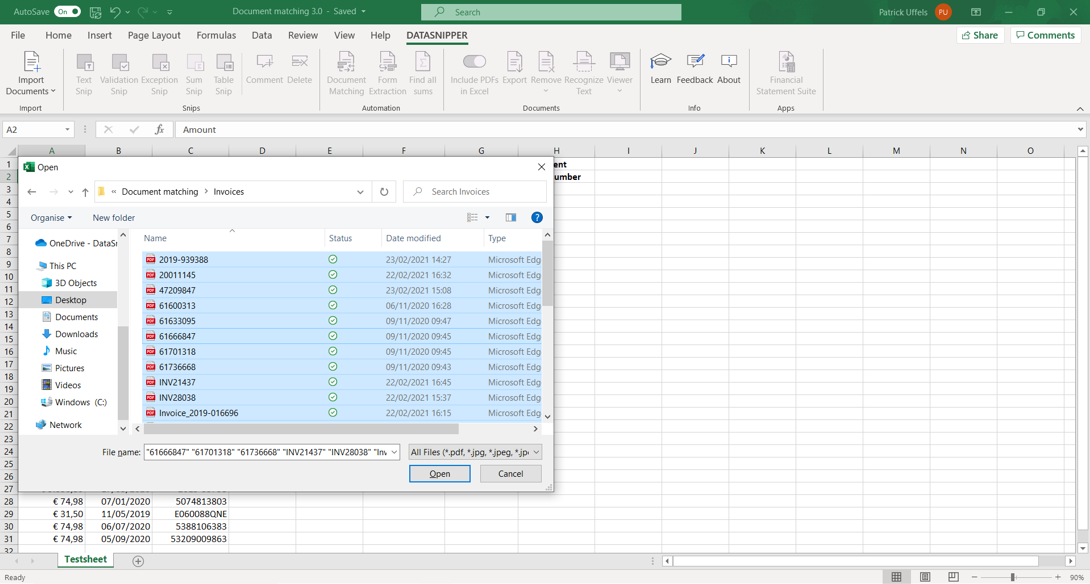
Select Documents
- First, we need to make groups for every Document type
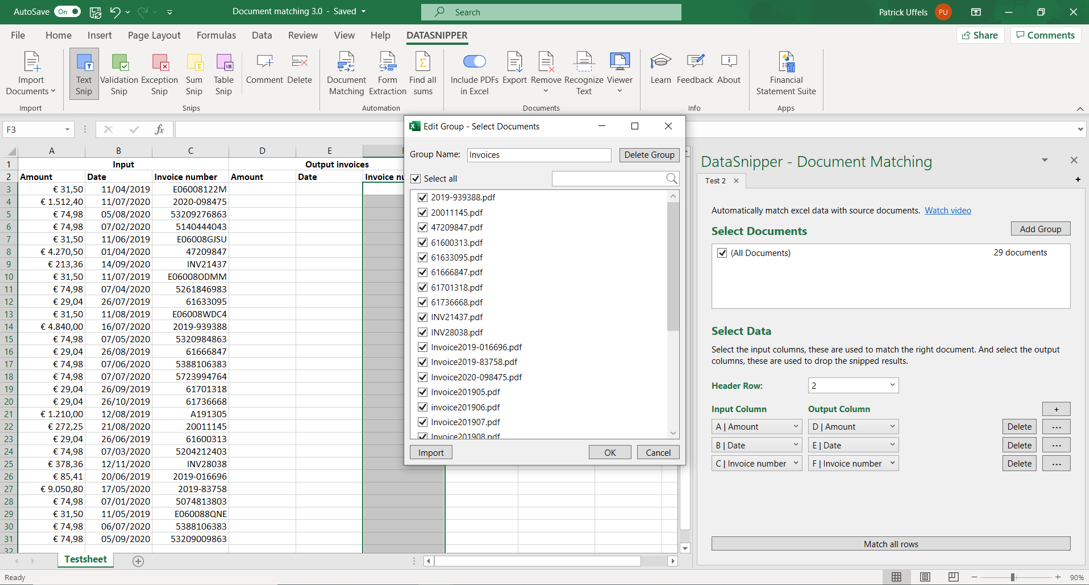
- Make the group for invoices first. Give the group a name, and select all invoices.
- Now let's add a group for The Bank statement and import the Bank statement document directly into the new group.

- Make sure to select the groups you want to include in your test of detail.
Select Data
- Select header row, this is the row where the header is located
- Select the input column, for example, the amount column
- Select the output column, So DataSnipper understands where it should output its results
- Click the add icon to create new rows. E.g. if you have 3 data field columns in your sample data, you need 3 rows in the input and output selector
- Repeat the steps above for all sample data fields
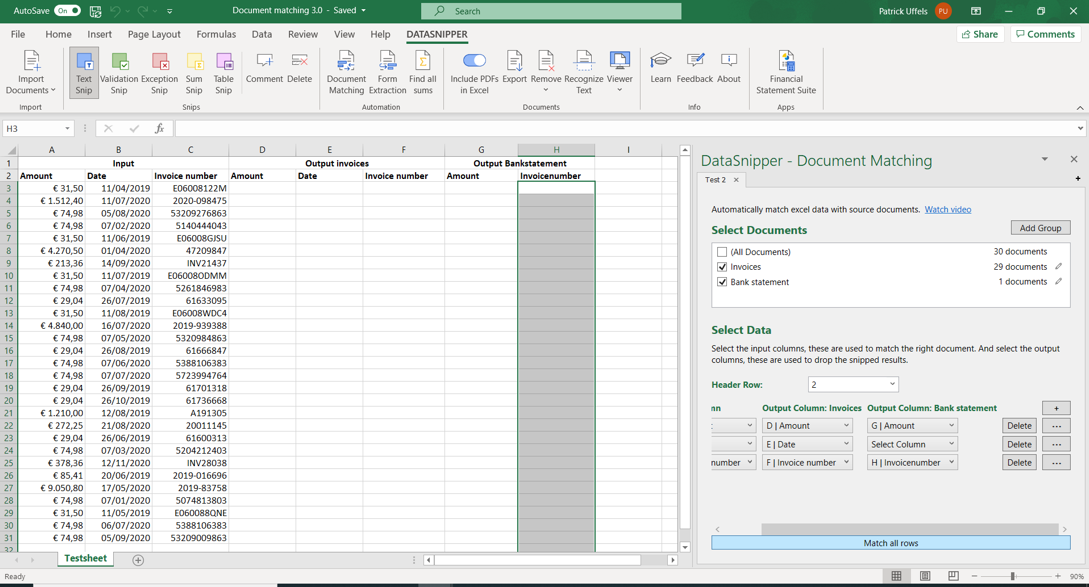
- Click Match all rows
- By clicking on the results, you can easily see the matched documents.
Review and Adjust
- Review the results and identify missing items
- In our example data, one amount field is still empty. After giving this a thought, there might be a rounding difference in the amount
- Let's set up a deviation in the document matching settings for the 'value amount' with 1
- You can do this by checking the allow difference checkbox and set the value to 1
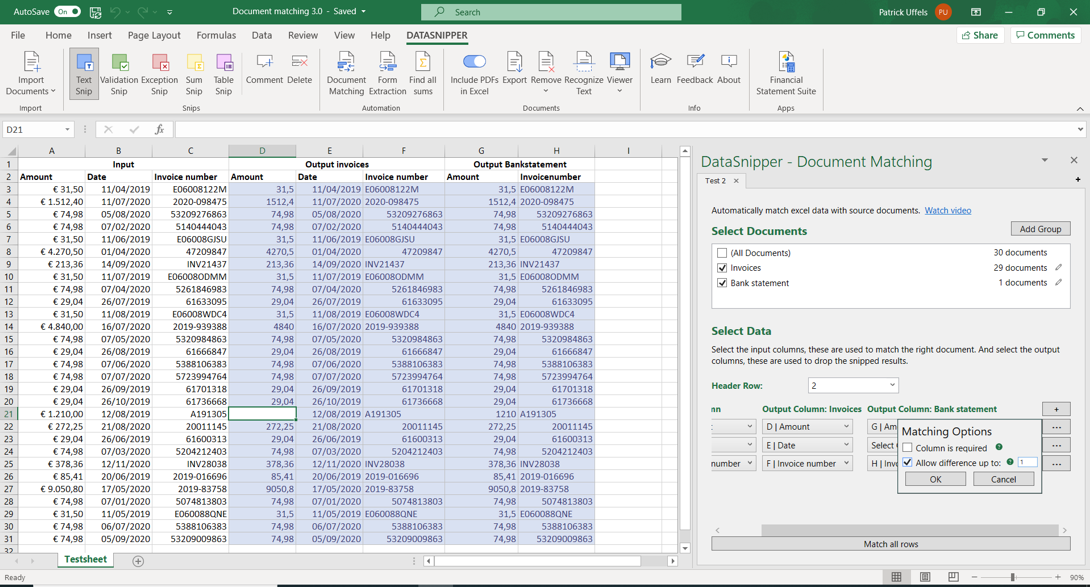
- Let's test again. Now you will see all information is matched and the cells are filled with data.
Increase the quality of your automated test
To finish, let's add additional rules to increase the quality of your tests
- Click on the options button in the Document Matching setup menu
- Here, you will see two advanced options:
- A checkbox to make the data in a column required
- A checkbox to allow deviations in the matched results, up to a certain value
For this example, the invoice number in the sample data is unique and available in the invoice and bank statement test data. Therefore, If no match can be found on the invoice number, we don't care about the rest of the values, as they are less trustworthy.
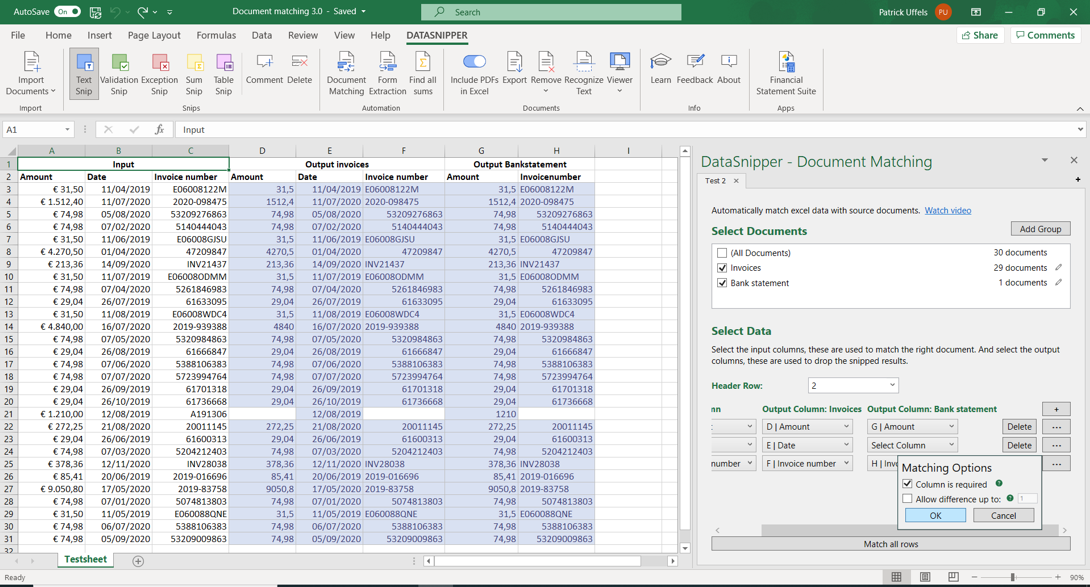
If you would like to learn how to perform multiple-way match, please read the article: How to use Document Matching with multiple document types
DataSnipper version 5.0 and later
Getting started with Document Matching
Learn how to get started with Document Matching, we will guide you through an example Invoice Vouching procedure. Once you understand the concept, you can apply the automation of Document Matching on different vouching and reconciliation procedures.
Video Tutorial
Step-by-step
Prerequisites
- Received documents from the client
- Sample data ready in Microsoft Excel
- Determine the data fields you like to test
- DataSnipper version 5.0 or later
Start Document Matching
- Start by importing documents. You can do that by clicking on the Import documents button or Document Organizer button.
- Once you have imported your documents, click on "Document Extraction" and click "Start new Document Matching".
- Select the cells which contain your sample data.
- If your sample data includes headers, check on the box "First row includes headers".
- Click on "Next Step".
- Select how to reconcile your documents. If you are performing a one-way match, select all documents and click the next step.
- In version 5, DataSnipper will automatically select the output columns for you. You can always manually adjust them according to your procedure.
- After double-checking your output columns, click Match all rows and DataSnipper will automatically match the input and output columns for you.
- Once the match is complete, use your professional judgment to validate the results.
If you are performing multiple-way matching, please read the article, How to use Document Matching with multiple document types.
Saving Templates
If you would like to use the same Document Matching setup in the future for different documents, you can do so by saving it as a template.
- Click on Save as template.
- Give your template a name and a description (optional).
- Once you click OK, your template will be saved in the My Templates tab in Document Matching.
⚠️ Saving templates in Document Matching is only available for DataSnipper version 5.0 and later. Please get in touch with your Customer Success Manager to learn more about DS version 5.0.
FAQs
- Can you include inputs in Document Matching without the tool having to output the snips in Excel?
No, Document Matching always returns the snip value on a document; you can always delete the output but it's not possible to create snips without outputting in Excel. In simple words, for each input you want to include in Document Matching, there should be an output.
If you are performing multiple-way matches (using doc groups) then you don’t need to specify an output for every single document group. - If the supporting documents (e.g. invoices) are 2-3 pages long, will Document Matching still pick up the correct inputs (e.g. let’s say the amount is located on the third page of the document)?
Yes, Document Matching has an algorithm which ranks multiple hits, one of the main ways of ranking is the proximity of all the snips on the page so generally this will work. - What happens if you select 'No' to the message 'The output area is not empty. Do you want to overwrite the rows that contain data?’?
If you select 'No', then Document matching will only populate empty rows. You can select this option for example when performing the next batch of sample items or if you want to revisit one of your Document Matching selections and then run the tool.